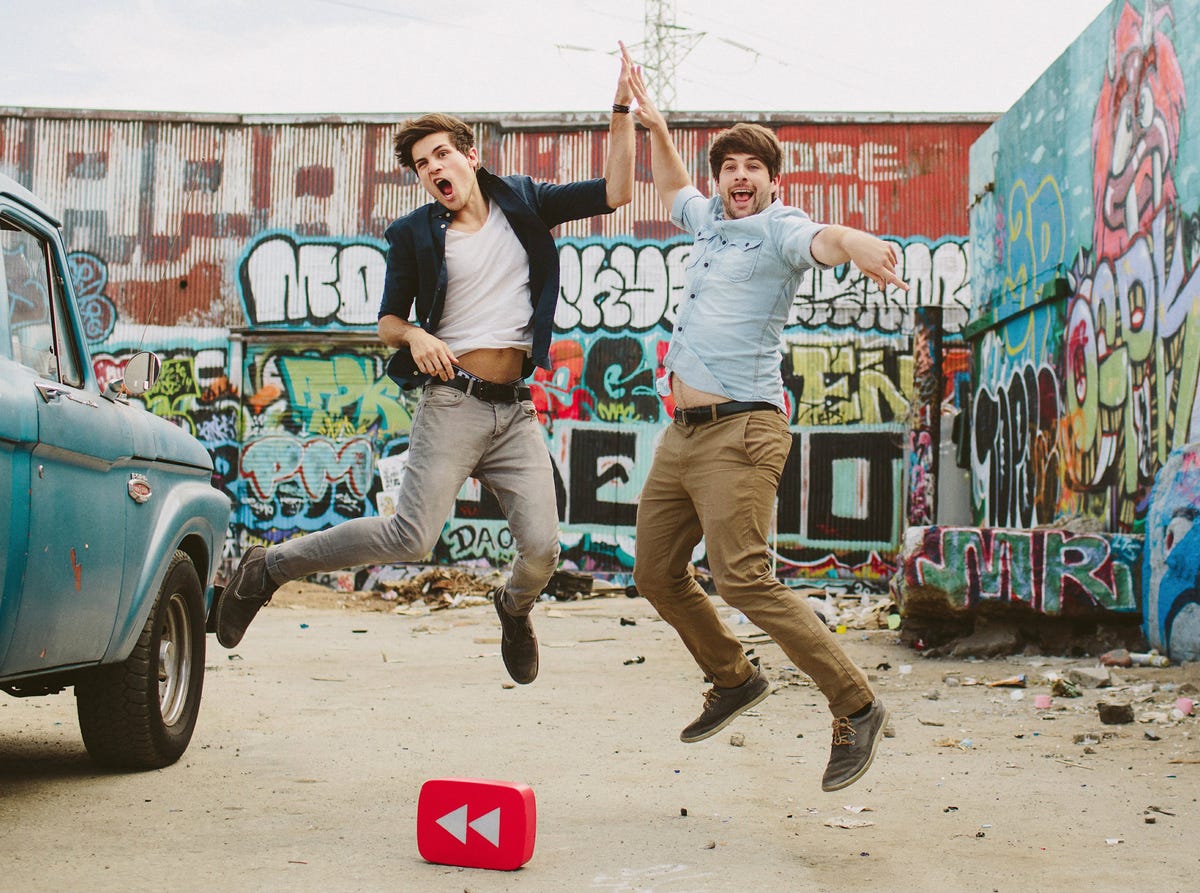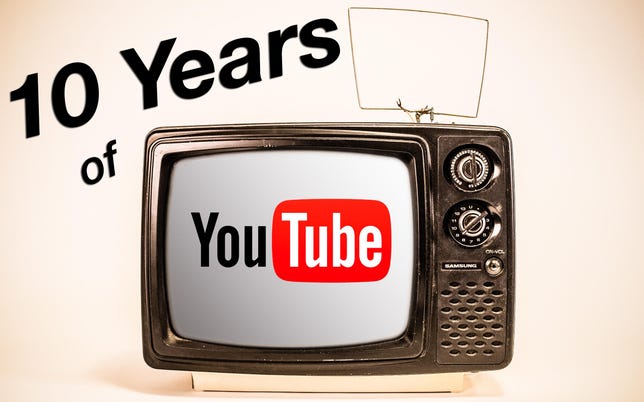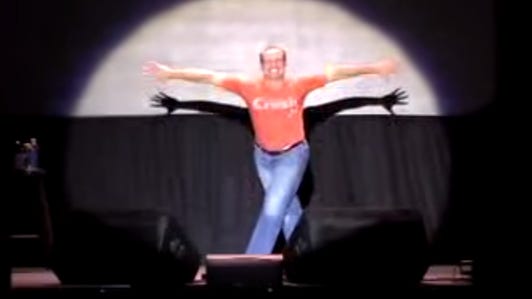
YouTube
Hanging out on a graffiti-coated movie set in Los Angeles in October, Anthony Padilla and Ian Hecox laugh as they recall the first time they were recognized in public.
It was 2005, and the two were visiting a Subway shop in their hometown of Sacramento, Calif., when a customer spotted them as the “Mortal Kombat guys” from YouTube.
Calling themselves Smosh, the shaggy-haired teens had lip-synched the video game’s theme song and pretended to high kick each other in a mock fight staged in Padilla’s childhood bedroom. The sandwich buyer told them what he thought of their 3.5-minute video — his review included an expletive and the word “sucked” — and then asked: “You guys take that shit seriously?”


James Martin/CNET
They certainly do, and they’re not the only ones.
Smosh’s send-ups of video games and movies have spawned a multimillion-dollar brand for the now 27-year-olds. Their Mortal Kombat takeoff has been watched more than 27 million times, while their channels on Google’s YouTube video site have tallied more than 7 billion views. Their fan base sometimes swarms into mobs the pair calls “scary.” Today, more than 20 million people subscribe to their main YouTube channel.
If that sounds outlandish, are you old enough to rent a car?
Thanks to the popularity of online media sites such as YouTube, today’s fastest-rising stars aren’t coming out of Hollywood. They’re teens hamming it up or breaking it down in front of a computer to create a new kind of entertainment.
Star quality
These stars might be nobodies to many viewers over 25, but that won’t last long. Baffled by how to reach the most coveted and commercially influential audience — 16- to 34-year-olds — Hollywood’s biggest players are starting to back these invisible celebrities.
“The star-making machine is outside big corporations for the first time,” says Jason Hirschhorn, a longtime digital media executive and CEO of news curation site Redef. “The idea of what something costs or the craft that’s involved … is totally lost on the younger generation. They look at whatever entertains them.”
What entertains them can be found more often on the Internet. Today’s younger audience watches more than a third of their “TV” online, nearly triple the percentage viewed by people 35 to 64, according to a Verizon survey last year. Young people also put more stock in stars like Smosh than in big-name celebrities.


YouTube
A study commissioned last year by Variety measured the Q scores — a media-industry gauge of familiarity and appeal — of YouTubers and traditional stars among US teens 13 to 17. The best five scores? All online video stars, with Smosh ranking No. 1, ahead of celebrities such as actress Jennifer Lawrence and singer Katy Perry.
For consumers, what passes for “premium content” will look more and more like that kid clowning for a laptop camera.
The power of creators
Want to behold the mania of online fandom? Head to VidCon, an annual confab held in Southern California where the biggest YouTubers — the term for anyone making a career through the site — draw their most obsessed fans.
The three-day event attracted more than 19,000 attendees last year, up from 1,400 visitors four years ago when it began.
“It’s absolutely nuts,” says Smosh’s Hecox. “Every YouTuber, it’s required for them to get a security escort.”


Joan E. Solsman/CNET
Teen girls make up the core at gatherings like VidCon and other live “social star” events, including DigiTour and DigiFest. Thousands flock to see their beloved icons from YouTube and Vine, Twitter’s video service of six-second clips.
Teenybopper fan crazes are nothing new, and today’s parents may be just as perplexed by YouTube stars as their parents were by MTV, even as Beatlemania stumped the previous generation. But with The Beatles, the older crowd knew the Fab Four were those floppy-haired boys on “The Ed Sullivan Show.”
Today, many don’t know who these online stars are, says Meridith Valiando Rojas, co-founder and CEO of DigiTour Media, which organizes performances for online stars. DigiTour expects its 2015 slate of 141 stage shows and concerts to attract 350,000 attendees, up from 120,000 last year.
“If I can’t name a social star, how can they be so famous?” she says, explaining the typical view of online celebrity.
But famous they are.


Joan E. Solsman/CNET
Andrea Russett, a teen who kept her YouTube videos a secret from her Fort Worth, Ind., classmates for fear of being teased, has millions of followers who chase her down the street like Britney Spears.
The 19-year-old has collected 2 million subscribers over six years of video blogging, or vlogging. When she moved to LA after turning 18, her YouTube clips of teen-life opinions and high jinks reeled in sponsorships from Pizza Hut and Sour Patch Kids.
“This is our business,” Russett says of the vlogs she and her three roommates, also YouTubers, create.
With top online stars, business can be big.
Money talks
Beauty vlogger Michelle Phan started posting makeup tutorials in 2007 after being turned down for a job at a Lâncome beauty counter. Those tutorials evolved into a YouTube channel with more than 7 million subscribers and more than 1 billion views. Her explainers are now the foundation of a mini-empire that includes a L’Oréal makeup line, a book of beauty tips, and a $10-a-month service called Ipsy that delivers “glam bags” of cosmetic samples to more than a million subscribers.


Mark Von Holden
“As my YouTube following grew, I was soon earning as much from advertising revenue as from waiting tables, so I quit my job,” says Phan. “My boss thought I was crazy, which just made me more determined.”
Phan, 27, hasn’t disclosed revenue from her ventures, but Ipsy’s subscriber base alone suggests an annual sales rate of about $120 million.
Missing the point
Though it has turned some online stars like Phan into moguls, YouTube’s economic draw still pales in comparison to broadcast and cable TV. Spending on all interactive marketing last year was about two-thirds of the $84.5 billion in advertising revenue that US TV networks pulled in, according to Forrester Research.
That money problem, and a lack of understanding about digital media, explains why many of Hollywood’s traditional players have been slow to recognize the economic potential of online entertainment.
Take Alexis G. Zall, whose talent agency was unimpressed when her YouTube channel of comedy vlogs reached 100,000 subscribers. Hitting that subscriber mark is a key milestone for landing lucrative product placement deals.
“They were like, ‘It’s just the Internet,’ ” says the 16-year-old aspiring actress, who writes, produces and edits her videos while taking online college courses. “They didn’t see the business possibilities.”
Forrester estimates spending on interactive marketing will eclipse TV ad revenue next year. And nothing beats YouTube for reach. With more than 1 billion unique visitors a month, YouTube attracts one out of every seven people on the planet. Stats like that have the old guard paying attention.
Viral stars of YouTube (pictures)






+7 more
Joining the mainstream
Maker Studios is the most eyebrow-raising example of how traditional Hollywood is starting to value online video and why this content won’t be invisible to the mainstream for long.
An online content creator and curator, Maker oversees a network of 55,000 YouTube channels that attract more than 10 billion monthly views. Walt Disney bought Maker for $500 million last year, with the total deal value at nearly $1 billion if Maker meets performance targets. Disney CEO Bob Iger says he wanted Maker in part for its expertise in creating and distributing “short-form videos.”
Courtney Holt, chief strategy officer at Maker Studios, says his conversations with traditional Hollywood forces no longer focus on justifying YouTube content. “I don’t have to apologize anymore because it’s undeniable how much demand there is,” he says.
The takeover also highlights a growing trend: mergers and acquisitions driven by fear of missing out on an entire generation of viewers.
In May 2013, DreamWorks Animation bought teen-skewing channel AwesomenessTV for $33 million. In July 2014, Viacom took a minority stake in Defy Media, which bought Smosh in 2011 for an undisclosed sum. In September 2014, media executive Peter Chernin and AT&T bought a majority stake in Fullscreen, a rival to Maker, that values it at as much as $300 million.
Language lessons
The deals are a recognition that Hollywood’s biggest media companies need to speak the digital language, says Laura Lee, YouTube’s head of North American content partnerships. “Sometimes if you can’t build it, you have to buy it.”
When media’s gatekeepers rush in, no audience — young or old — will be oblivious to this new form of entertainment, notes Kevin Mayer, the executive vice president who spearheaded Disney’s Maker purchase.
“They’re going to have to care,” he says. “That’s the kind of content they will be consuming.”
For proof, look at Smosh. They just shot their first full-length film, which will be distributed this year by Lions Gate Entertainment — home to “The Hunger Games” and “Twilight” blockbuster film franchises.
“When we first started, people were like, ‘Ha ha, you make cat videos’ … But we felt that there was something there,” Padilla says in between publicity photos at the LA film lot. “I’m going to do this for the rest of my life.”






